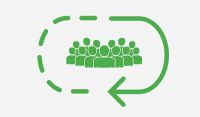Public Goods Games
Voting is an example of a public good within democratic societies, as it is necessary to hold public representatives accountable. However, it requires that citizens make informed decisions that may cost them both time and effort that they personally will not receive an immediate reward for.
Public goods games are social dynamics that involve three main components: they involve resources that are jointly provided; the resource is non-excludable in nature; it is also non-rivalrous.1 Economic theory describes the problem of public-good provision through individual contributions as a game in which agents have to decide how much of some resource to contribute to the creation of a public good and how much to spend on private goods. Owing to the non-rival and non-exclusive nature of the public good, the prediction made by equilibrium analysis is that players have incentives to free-ride on others and therefore individual contributions will be suboptimal. This effect is known as a social dilemma in the broader literature.2
A social dilemma is, as Baron (2000) notes, a situation where “each person benefits by consuming the fruits of others’ labor and laboring himself as little as possible—but if everyone behaved this way, there would be no fruits to enjoy”(p. 434) The public goods game is the game theoretical version of the social dilemma. Public goods games are usually employed to model the behavior of groups of individuals achieving a common goal. The public goods game has the same properties as the prisoner’s dilemma game, but describes a public good or a resource from which all may benefit regardless of whether or not they contributed to the good.3
A good example of this might be storekeepers with shops in the same street. They can collaborate, i.e. invest some money, in improving the street—creating more parking places, better lighting, etc.—to create benefits that will be shared by all the stores: i.e. more customers circulating in the street. However, some of them can decide not to contribute to the improvements, saving some money while still sharing in part of the added value created by the community. Another example of a public goods game could be seen in how people may use a city park, regardless of whether they contributed to its upkeep through taxes. Most public goods are collectively shared and are non-excludable – once they have been provisioned it is difficult to exclude people from them. As a result, there is a temptation to enjoy the good without making a contribution. Those who do so are called free-riders – like taking a free-ride on public transportation – and while it is narrowly rational to free-ride, if all do so the public good is not provided and all are worse off.
Model
Public goods games model the core dynamic of complexity at the heart of large social groups
We can understand the underlying structure here by looking at a basic lab version of the public goods game.4 In this experiment, people come into the lab and are all given 100 tokens. They are then given a choice of whether they keep their tokens or put them into a common pool, people put their contributions into the pool in secret. The pool is then doubled and then divide equally among everyone. Each subject can also keep the tokens they do not contribute. Those who contribute below average or nothing are called “defectors” or “free riders”, as opposed to the above average contributors who are called “cooperators”.
The group’s total payoff is maximized when everyone contributes all of their tokens to the public pool, but each is incentivized to not contribute, as keeping their money will render them the potential greatest payoff. Thus the Nash equilibrium in this game is simply zero contributions by all; if the experiment were a purely analytical exercise in game theory it would resolve to zero contributions, because any rational agent does best contributing zero, regardless of whatever anyone else does. However, the Nash equilibrium is rarely seen in experiments; people do tend to add something to the pot. The actual levels of contribution found varies widely – anywhere from 0% to 100% of the initial endowment may be contributed by the members.
“Repeat-play” public goods games involve the same group of subjects playing the basic game over a series of iterations. In experiments of repeated play public goods games done around the world, where players could punish other players for the way they played in the last round, by paying in a low amount so that the other also receives a low payoff, even though the experiments are exactly the same the result varies greatly from one location to another.
In some places like parts of Germany and Denmark, the cooperation in these games starts off high and remains high. In another part of the world like Korea, cooperation starts out in the middle and then over time increases to a sustained high level. In other parts, it starts low and remains low. In these experiments, there was also seen to be a correlation between the degree of cooperation in the game and responses to questions on the world value survey that deals with people’s response to issues of public cooperation.5
Tragedy of The Commons
The issue of the tragedy of the commons is an ancient one, as expressed by Aristotle over two thousand years ago when he said, “What is common to many is taken least care of, for all men have greater regard for what is their own than for what they possess in common with others.”
Most common resources are public goods because they are not excludable. However, they are often rivalrous in consumption, because their use diminishes the value or lessens the quantity available to others. This is best illustrated by the parable of the Tragedy of the Commons. As an example of the Tragedy of the Commons, we can think about medieval England where farmers used to raised sheep and allowed them to graze on common land that was freely available to everyone. When the population was small, the land could replenish itself on its own. However, as the population grew, they needed more sheep, so eventually, the land was being over-grazed to a point where it could not replenish itself. Eventually, there was not enough common land to support the number of sheep. The reason why this occurs is that the costs are being externalized and thus they are not being factored into the costs and benefits to the individuals. Because anyone can use the land for grazing, no one has any incentive to regrow the grass, to protect it, or to limit the number of sheep grazing on it.6
Social Traps
The tragedy of the commons illustrates one of the most interesting parts of the social dilemma, what is called a social trap. A social trap occurs when individuals or groups pursue immediate rewards that later prove to have negative or even lethal consequences.7 This type of dilemma arises when a behavior produces rewards initially, but continuing the same behavior produces diminishing returns. Stimuli that cause social traps are called sliding reinforcers since they reinforce the behavior in small doses and punish it in large doses. An example of a social trap is the use of vehicles and the resulting air pollution.
Viewed individually, vehicles are an adaptive technology that has revolutionized transportation and greatly improved quality of life in many ways. But their current widespread use causes negative externalities. In many places, air pollution continues unabated because the convenience of driving a car is immediate and the environmental costs are distant and often do not become obvious until much later. The social trap is interesting because in many circumstances the members performing the destructive action can see that their actions will lead to disastrous long-term outcomes. But if they are motivated by mere short terms self-interest they will find no way to avoid it, thus creating a trap or tragedy.
1. (2017). Econ.ucsb.edu. Retrieved 13 May 2017, from http://econ.ucsb.edu/~oprea/176/PublicGoods.pdf 2. (2017). Www3.grips.ac.jp. Retrieved 13 May 2017, from http://www3.grips.ac.jp/~econseminar/Public-good_games.pdf 3. (2017). Tcd.ie. Retrieved 13 May 2017, from https://www.tcd.ie/Economics/assets/pdf/SER/2000/Liam_Delany.pdf 4. The Public Goods Game. (2017). YouTube. Retrieved 13 May 2017, from https://www.youtube.com/watch?v=4IIQrgplLu4 5. The Public Goods Game. (2017). YouTube. Retrieved 13 May 2017, from https://www.youtube.com/watch?v=4IIQrgplLu4 6. (2017). Garretthardinsociety.org. Retrieved 13 May 2017, from http://www.garretthardinsociety.org/articles_pdf/tragedy_of_the_commons.pdf 7. (2017). Web.mit.edu. Retrieved 13 May 2017, from http://web.mit.edu/curhan/www/docs/Articles/15341_Readings/Negotiation_and_Conflict_Management/Platt_1973_Social_traps.pdf










